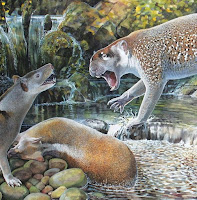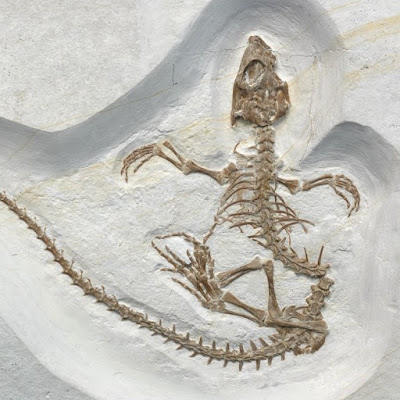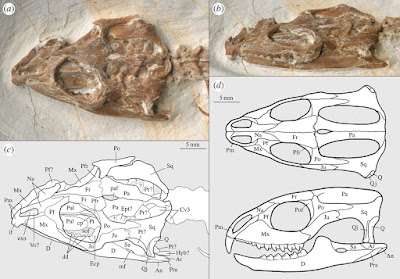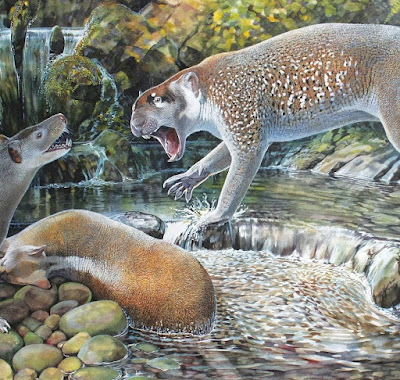[Most Recent Entries] [Calendar View]
Monday, December 11th, 2017
| Time | Event | ||||
| 7:05a | [Paleontology • 2017] Vadasaurus herzogi • A New Rhynchocephalian (Reptilia: Lepidosauria) from the Late Jurassic of Solnhofen (Germany) and the Origin of the Marine Pleurosauridae
Abstract A new rhynchocephalian is described based on a recently discovered and well-preserved specimen from the Late Jurassic (Kimmeridgian) marine limestones of Solnhofen, Bavaria. Phylogenetic analysis recovers the new taxon as the sister group to Pleurosauridae, a small radiation of rhynchocephalians representing the oldest marine invasion of crown-clade Lepidosauria. The relatively strong evidence for this taxonomically exclusive lineage, within a generally volatile rhynchocephalian tree, places the new taxon in a position to inform the early history of the pleurosaur transition to the sea. The early steps in this transition are distributed throughout the skeleton and appear to increase hydrodynamic efficiency for both swimming and aquatic feeding. This early history may also have included a global truncation of plesiomorphic ontogenetic trajectories that left a number of skeletal features with reduced levels of ossification/fusion. The exact degree to which Vadasaurus had adopted an aquatic ecology remains unclear, but the insight it provides into the origin of the enigmatic pleurosaurs exemplifies the potential of Rhynchocephalia for generating and informing broad-based questions regarding the interplay of development, morphology, ecology and macroevolutionary patterns. KEYWORDS: Bavaria, marine reptile, secondarily aquatic, skeletal development, sphenodon, tiatethys Systematic palaeontology Lepidosauria Haekel, 1866 Rhynchocephalia Günther, 1867 Vadasaurus herzogi gen. et sp. no. Etymology: Generic name from the Latin vadare ‘to go forth’, which is also the root of ‘to wade’—refers to the taxon's hypothesized phylogenetic position near the proximal end of a terrestrial-to-marine transformation series that produced the aquatic pleurosaurs—and saurus ‘lizard’. The specific epithet honours the celebrated Bavarian film-maker Werner Herzog for his continuing exploration of the relationship between life and time. Holotype: AMNH FARB 32768, a nearly complete and largely articulated skeleton (figures 1–3). Like most specimens preserved in lithographic limestone, it exhibits compressional effects that include the flattening and shearing of composite structures and the slight displacement of certain elements. Individual bones, however, are preserved largely in three dimensions. Gabriel S. Bever and Mark A. Norell. 2017. A New Rhynchocephalian (Reptilia: Lepidosauria) from the Late Jurassic of Solnhofen (Germany) and the Origin of the Marine Pleurosauridae. Royal Society Open Science. 4(11):170570 DOI: 10.1098/rsos.170570 The fossil was recovered from Kimmeridgian-aged (a subdivision of the Late Jurrasic) marine limestones in the Solnhofen municipality of Bavaria, Germany. They belong to an up until now unknown species dubbed Vadasaurus herzogi, and belongs to the Rhynchocephalia lizard order, a close relative of a small group of ancient reptiles called pleourosaurs (genus Pleurosaurus). Fossilized ancient lizard shows how dinos evolved to live in the oceans zmescience.com/science/ancient-lizard-di | ||||
| 5:05p | [PaleoMammalogy • 2017] Wakaleo schouteni • A New Oligo–Miocene Marsupial Lion from Australia and Revision of the Family Thylacoleonidae
Abstract Wakaleo schouteni sp. nov., a dog-sized marsupial lion (Thylacoleonidae), is described from late Oligocene to early Miocene sediments of the Riversleigh World Heritage Area, Queensland, Australia. Fossils of this new species include a near-complete cranium, dentaries and postcrania. This species is the second thylacoleonid known from late Oligocene sediments. The other, Priscileo pitikantensis Rauscher, 1987, from the Etadunna Formation of South Australia, is known from teeth, part of a palate and postcrania. Wakaleo schouteni exhibits cranial and dental morphology characteristic of species of Wakaleo but possesses a relatively plesiomorphic upper dental formula (i.e. three premolars and four molars) within Thylacoleonidae that was formerly regarded to be diagnostic for species of the genus Priscileo. The holotype and humerus of P. pitikantensis have been compared with the new Wakaleo material described here and found to demonstrate conspicuous similarities in morphology of the M2 and the humerus. In the absence of other generically diagnostic features, Priscileo is here regarded to be a junior synonym of Wakaleo. Smaller size and relatively minor morphological differences in the proximal humerus of W. pitikantensis comb. nov. distinguish it at the specific level from W. schouteni. Phylogenetic analysis of thylacoleonids recovers Wakaleo as a monophyletic clade. Both Wakaleo pitikantensis comb. nov. and W. schouteni are recovered as plesiomorphic sister taxa to other species of the genus. Wakaleo pitikantensis and W. schouteni extend the temporal range for this genus back into the late Oligocene. Body weight for W. schouteni, based on total skull length, is estimated to be ∼23 kg. Keywords: marsupial lion, Thylacoleonidae, Oligocene–Miocene, taxonomy, Priscileo, Riversleigh Systematic palaeontology Class Marsupialia Illiger, 1811 Order Diprotodontia Owen, 1866 Suborder Vombatiformes Woodburne, 1984 Family Thylacoleonidae Gill, 1872 Genus Wakaleo Clemens & Plane, 1974 Type species: Wakaleo oldfieldi Clemens & Plane, 1974 . Included species: Wakaleo vanderleueri Clemens & Plane, 1974; Wakaleo alcootaensis Archer & Rich, 1982; Wakaleo schouteni sp. nov.
Wakaleo schouteni sp. nov. Derivation of name: Named in honour of Peter Schouten for his exceptional reconstructions of Australia's prehistoric animals, and in particular those from the Riversleigh WHA. Conclusions Craniodental and postcranial material of a new marsupial lion, Wakaleo schouteni sp. nov., is described from the Riversleigh WHA. Although this taxon has not reduced/lost the anterior upper premolars, previously regarded to be diagnostic for Wakaleo, it exhibits other Wakaleo apomorphies of the skull and molars. Comparison of the holotype of Priscileo pitikantensis Rauscher, 1987 from the Ngapakaldi LF with Wakaleo schouteni sp. nov. and other Wakaleo species reveals apomorphies of the M2 and similarities in humerus morphology that support its referral to Wakaleo. Priscileo pitikantensis is therefore regarded as a junior synonym of Wakaleo pitikantensis comb. nov. Wakaleo schouteni is distinguished from W. pitikantensis on the basis of its different proximal humerus morphology and larger size, being 10% larger in most dental measures. Markedly different sizes in a sample of humeri of W. schouteni suggest this species was sexually dimorphic. Retention of three upper premolars and four molars are symplesiomorphic features for Wakaleo and Priscileo but distinguish W. pitikantensis and W. schouteni from later species of this genus, all of which exhibit premolar and molar reduction. These two species are the most primitive members of the genus and indicate a pre-late Oligocene origin for the lineage. Anna K. Gillespie, Michael Archer and Suzanne J. Hand. 2017. A New Oligo–Miocene Marsupial Lion from Australia and Revision of the Family Thylacoleonidae. Journal of Systematic Palaeontology. DOI: 10.1080/14772019.2017.1391885   Fossils of ancient marsupial lion discovered in north-west Queensland AustralianGeographic.com.au/news/2017/12/f |
| << Previous Day |
2017/12/11 [Calendar] |
Next Day >> |







